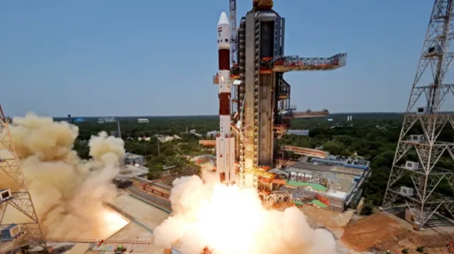A GLIMPSE INTO ONGOING INDIAN SPACE MISSIONS
Context:
The Indian Space Research Organisation (ISRO) has been actively advancing India’s space capabilities through a series of landmark missions. Over the past year, significant strides have been made with missions like Chandrayaan-3, Aditya-L1, and the upcoming Gaganyaan mission. These missions not only enhance India’s scientific and technological prowess but also position India as a key player in the global space arena. This editorial analysis focuses on the ongoing Indian space missions, highlighting their importance, technological advancements, and implications for India’s strategic interests.
Source : Indian Express
Key Ongoing Missions
Chandrayaan-3: A Milestone in Lunar Exploration
Chandrayaan-3, with its successful soft landing on the Moon’s south pole, marked a significant achievement for ISRO. The mission focused on exploring the lunar surface, particularly its southern latitudes, an area unexplored by previous missions. The insights gained from this mission have provided critical data on the Moon’s geological history, supporting the lunar magma ocean hypothesis and revealing the composition of the lunar surface. These findings not only enhance our understanding of the Moon but also contribute to broader planetary science.
Aditya-L1: Probing the Sun
Launched in September 2023, Aditya-L1 is India’s first solar mission aimed at studying the Sun’s corona and solar radiation. Positioned at the Earth-Sun Lagrange point (L1), this mission will provide unprecedented data on solar activities, including solar flares and their impact on space weather. Understanding solar dynamics is crucial for protecting satellites and communication networks, which are vulnerable to solar storms. Aditya-L1 underscores India’s commitment to space science and its efforts to contribute valuable data to the global scientific community.
Gaganyaan: India’s Crewed Spaceflight Ambition
The Gaganyaan mission represents India’s ambitious foray into human spaceflight. The successful demonstration of crew safety systems in the Test Vehicle Demonstration-1 (TV-D1) mission has paved the way for the maiden crewed flight planned for the near future. Gaganyaan aims to send Indian astronauts, or Vyomanauts, into space, making India the fourth country to achieve human spaceflight capabilities. This mission will not only boost India’s technological capabilities but also inspire a new generation of scientists and engineers.
Next-Generation Launch Vehicles:
ISRO is working on developing next-generation launch vehicles to enhance its payload capacity and reduce costs. These advancements are crucial for maintaining India’s competitive edge in the global satellite launch market. The focus on reusable launch vehicle technology is particularly noteworthy, as it aligns with global trends towards sustainable and cost-effective space exploration.
Private Sector Involvement and Commercial Missions
The Indian space sector is witnessing increasing participation from private companies, driven by reforms and policy changes. The recent guidelines for space activities have opened up opportunities for private entities to collaborate with ISRO and engage in independent missions. This shift is expected to accelerate innovation, enhance efficiency, and contribute to the commercialization of space. The involvement of private players will not only boost the economy but also help in achieving self-reliance in space technology.
| Implications for India’s Strategic Interests
Technological and Scientific Leadership:
Strategic Autonomy and National Security:
Economic Growth and Innovation:
International Collaboration and Soft Power:
|
Conclusion
Understanding the scope and significance of India’s ongoing space missions is crucial for grasping the broader narrative of India’s scientific and strategic advancements. These missions highlight India’s commitment to innovation, self-reliance, and global cooperation. As India continues to explore new frontiers in space, it not only paves the way for scientific discovery but also secures its position as a key player in the evolving global space landscape. The success of these missions will inspire future generations and drive India’s growth in science, technology, and strategic capabilities.




